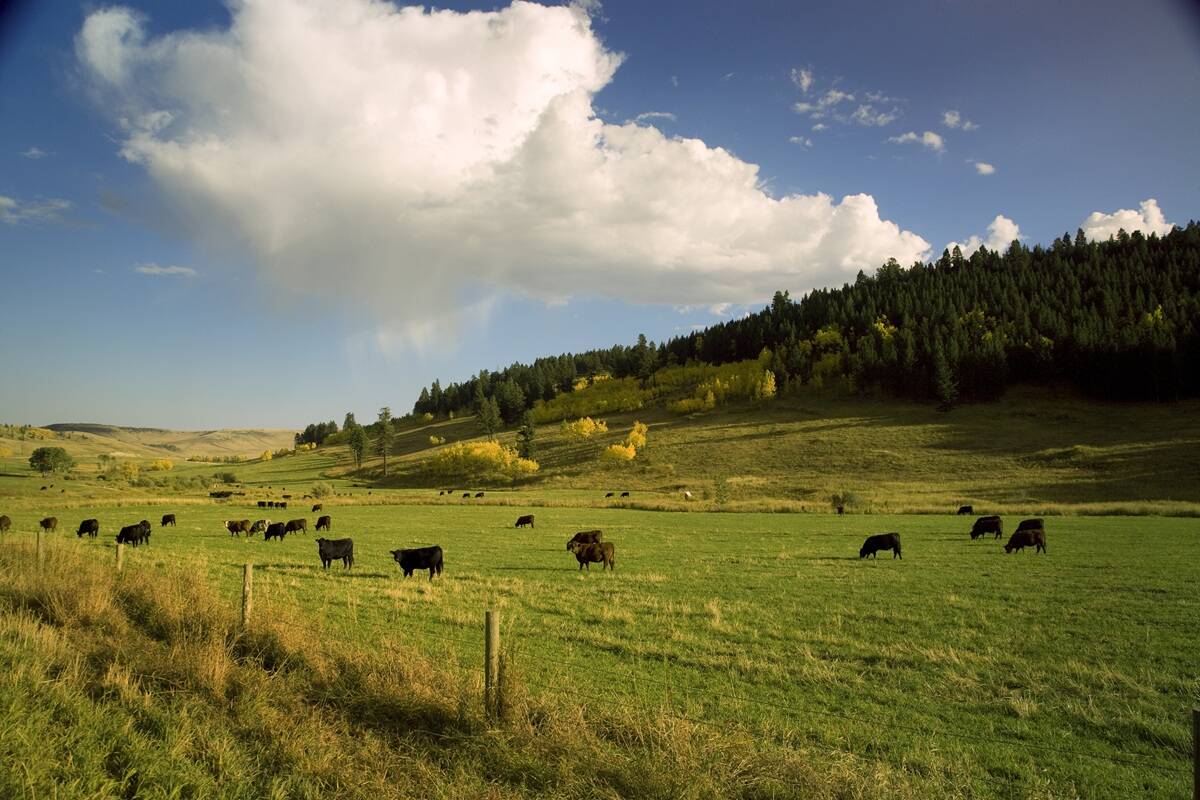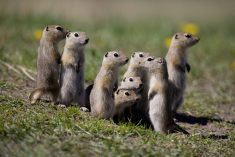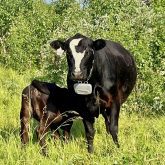Grazing a piece of ground rather than haying it can have some advantages. Even irrigated pasture can be more productive than the same ground used for haying, especially with rotational grazing and good management. Irrigated pasture has high production potential and ability to regrow rapidly, especially if water is put back on it right after it’s grazed. This accelerates regrowth.
In many situations, well-managed pasture under centre pivots will meet or exceed hay production potential, and you don’t give up any productivity by grazing it instead of haying. You have more days of active growth. It only grows up once or twice for hay (sometimes more, in a long growing season) but you can have multiple “cropping” with rotational grazing. Traditionally, most farmers felt that good irrigated land was worth too much as crop ground to use as pasture, but sometimes you can make as much or more per acre utilizing it for beef production, depending on how you manage the pasture.
Read Also

Are you a competitive supplier of weaned beef calves?
Beef farmers and ranchers need to strategically manage costs to achieve and maintain profitability.
According to Karin Lindquist, a forage/beef specialist for Alberta Agriculture and Forestry in Stettler, when you take forage for hay you are exporting nutrients from the land, unless you feed that hay to cattle on the same piece of ground.
“Nutrients need to be returned, to maintain productivity. If you continually harvest hay and take nutrients from the soil, you have to add them back with fertilizer, which is an added cost for haying,” she explains. By contrast, if cattle are grazed on that piece of land, organic matter and fertilizer are added back into the soil via manure and trampled vegetation.
“Cattle return 80 to 90 per cent of what they consume back onto the land. This seems inefficient but when cattle are mobbed up with intensive grazing and moved to new pasture daily, each area gets an equal amount of trampling and manure to stimulate regrowth. This adds fertility and reduces the need for purchased fertilizer,” she says.
It depends on what the producer wants from the land, and the level of production desired. Eliminating the expense of fertilizer, however, may tip the scales toward grazing being the more profitable situation.
Bart Lardner, a research scientist and adjunct professor at the University of Saskatchewan says most of the pastureland in Canada is dryland rather than irrigated, and there haven’t been a lot of comparisons in terms of profit per acre with grazing rather than haying, but a few studies have been done.
Dryland hay versus grazing
“We did a three-year study stockpiling forage to graze later, letting it grow, and grazing it late fall into winter. We compared this with a common haying system where forage in those same fields was put up in round bales, taken back to the yard and fed to cattle in drylot during winter months. We compared grazing the cattle on stockpiled forage with feeding the bales — looking at the cost of machinery, the cost to put up the hay and bring it back to the yard,” he says.
“Our system costs were about 15 per cent less having the cattle out there doing the harvesting themselves, versus taking it off for hay. That was an advantage, just letting cattle graze the forage. But as it got colder, into December, we had to provide an energy supplement, which negated any cost saving. There was about a 40- to 50-day window where the cows could just graze the forage, but we get cold winters here and have to think about additional energy. Once we had to supplement, we lost the cost advantage.”
In some situations when stockmen have been putting up hay but their haying equipment is getting older and they are looking at the cost of replacing it, they might consider grazing that ground instead of haying, utilizing intensively managed grazing to maximize pasture production.
“There are some trade-offs. When you put up hay you have to consider harvesting costs, fuel, machinery repair, loss of leaves when rolling it up into a bale, transport costs, etc. Yet you can maximize utilization of forage in those round bales when you feed them in a pen. We found a little bit lower utilization when grazing the forage because of trampling, etc.”
On the flip side, the trampling, urine and manure from the cattle during grazing adds fertility to the soil and increases production potential for the next year — and may also save the cost of buying fertilizer. “It’s a pro and con, and people have to decide what works best for them. We saw increased soil nutrients from the manure in a grazing system,” says Lardner. If you only take the forage off as hay and never feed it back on that field or graze the field, you are removing nutrients and have to replace them, usually with commercial fertilizer, which is becoming more expensive.
“Continual haying exports nutrients whereas the cows put it back. They never utilize every tuft of grass, but the litter and manure put the nutrients back to the soil,” he says.” In the end, you have better production with that organic fertilizer versus chemical fertilizer, and longer benefit. It’s a slower-release mechanism, with more benefit over time.
In most cases it doesn’t have to be a choice of haying or grazing.
“Producers also have the option to do both,” says Lindquist. “It might not be both the same year, but it could be — especially in a good year when it grows early and quickly. You could put up one crop of hay, let it regrow, then graze it, or you might allow it a rest from haying for a year and graze it instead,” she explains.
Irrigate hay/crops versus grazing
“If it’s a high-quality crop of forage and there’s opportunity to custom graze stocker cattle after hay harvest, this can be a profitable second crop. You could bring in yearlings to pasture on high-quality forage for good gains on the cattle. Cow-calf pairs will also benefit, with their high nutrient requirements for milk, and gains on the calves,” Lindquist says.
A producer can custom graze for other people, or use his/her own stockers to grow, or finish on grass. This option has a lot of potential if someone is considering pasture instead of haying. Irrigated pasture can produce adequate quality and quantity for finishing beef on forage.
Cattle can graze rotationally throughout the growing season and take advantage of high-quality forage at all times, making it lower risk even if the beef market is a gamble. Haying can be risky when trying to produce a high-quality, high-value hay crop because you are depending on timing and weather conditions; what might have had the potential to be a high-value crop may be damaged by rain and ends up being lower-value hay.
“We don’t see a lot of irrigated pasture here,” says Lardner. “There are some irrigated systems in Alberta and Saskatchewan but they typically are growing cash crops. The infrastructure (pivots, and getting water to those areas) is costly, so most farmers feel they need to grow something more valuable than cattle. There’s still a question, however, regarding whether you can get more returns per acre under an irrigation system by grazing cattle on a highly productive stand of forage versus a cash crop of pulse, oil seed or a cereal crop. We continue to explore this,” says Lardner.
“With irrigation you can control the water and usually have adequate water for the crop or pasture, whereas on dryland on a drought year you deal with lower production. With irrigation you have more consistent moisture. The real question is whether you can make more money growing a crop or growing pasture. What we see here under irrigation is growing a legume for hay, like dairy-quality alfalfa that’s worth more than grass hay. Some farmers are growing alfalfa and pelleting it. That’s where the shift has been, rather than putting cattle on irrigated pieces,” he says.
Yet in some situations, under intensive grazing systems on irrigated fields, there is potential to produce a lot of beef. “We can grow some very high-producing forage mixes and if a person is willing to rotate cattle through (moving them at least once or more per day) and strip-graze those pieces, you can get a lot of production.”
With intensive grazing, putting cattle on a strip for a short time and moving on, you can give forage ample recovery to be re-grazed many times during the growing season. In this situation you can possibly grow more total forage, without any inputs for fertilizer or haying costs, or risk of bad weather during harvest.
Weather is part of the gamble with haying and also with grazing, especially when using forage stockpiled in a fall and winter system. The biggest advantage might be for summer grazing, if you have irrigation to keep forage growing optimally through the entire grazing season. There are many options, and what works for one producer might not work at all for another.
“Some advantages of grazing include recycling soil nutrients and holding more carbon in the soil with perennial pastures, compared to an annual crop system, and environmental aspect,” says Lardner. It’s often better for the land and water systems to add fertility with cattle manure than with chemical fertilizers.
The potential for significantly reducing cost of machinery, maintenance, fuel, etc., is a factor when weighing options. Some people may prefer the labour involved in managed, intensive grazing, while others may think it is too much work.
“Setting up electric fence, watering points, and the shorter time spent moving the cattle is cheaper, however, than costs associated with haying, but often it comes down to personal preference, whether you want to play in the tractor or move cows!” Lindquist says.
She recommends evaluating management goals, the costs involved with various options, and what kind of profit you could potentially make from that piece of ground. “It doesn’t always have to be one or the other because you could do both. Look at the opportunities you might take advantage of, whether it’s the markets, or a neighbour with cow-calf pairs or stockers that need pasture.” Custom grazing can be profitable, eliminate the gamble of owning cattle yourself, and add fertility to your soil instead of continually taking away soil nutrients with a harvested crop.
Integrating cattle with crops
“Some of my colleagues in North Dakota are using cropping systems that include putting cattle on cropland to eat the crop aftermath,” says Lardner.
“The biggest benefit is the recycling via urine and feces. This is a new idea for some farmers because they worry about soil compaction with the cattle. But if you put them out there after the ground is frozen and bring them off before spring thaw you don’t have that problem. You can utilize cattle to graze cornstalks and residues from annual cereals — and get the manure out there.”
Cattle get the residues cleaned up and the farmer doesn’t have to burn or till them under. The land benefits from litter/manure. The farmer can have income from pasturing someone’s cattle. “We’ve done some work showing the benefits of 2.5 to three times the amount of ammonium and nitrate nitrogen out there, when animals have been on the land, versus just putting it on with equipment,” he says.
Some farmers are going back to the older way of sustainability when everyone had a mixed farm and a few livestock as well as crops; livestock recycled the nutrients and made cropland more fertile, and the animals benefited from crop aftermath, producing another crop (meat, milk, wool, etc.) from the farm.
“The plant-soil-animal interface is important and we need to think more about that. Crop farmers need to consider this, in partnership with livestock people.” The farmers don’t have to own the livestock; they can custom graze cattle on some of the crop aftermath — and send them home again after they’ve grazed it.
This article first appeared at AGCanada.com.
















